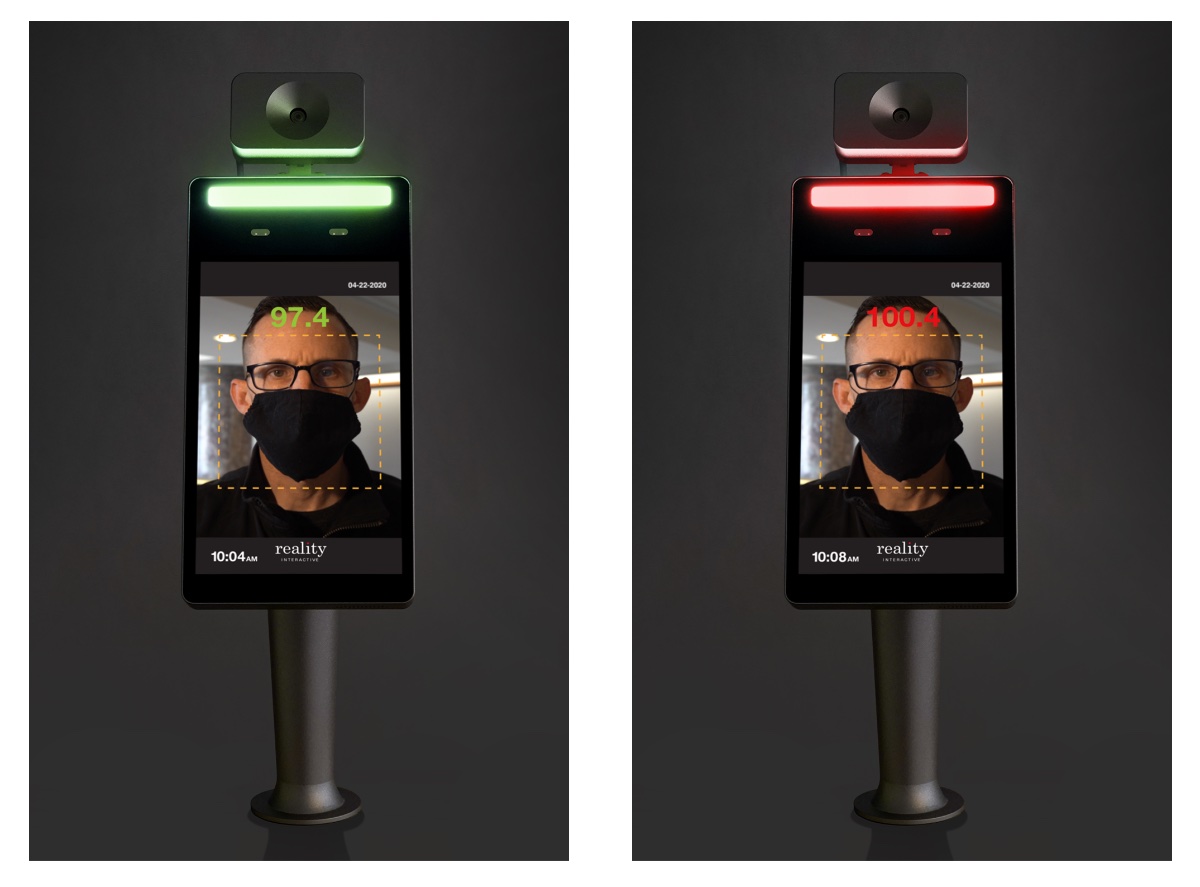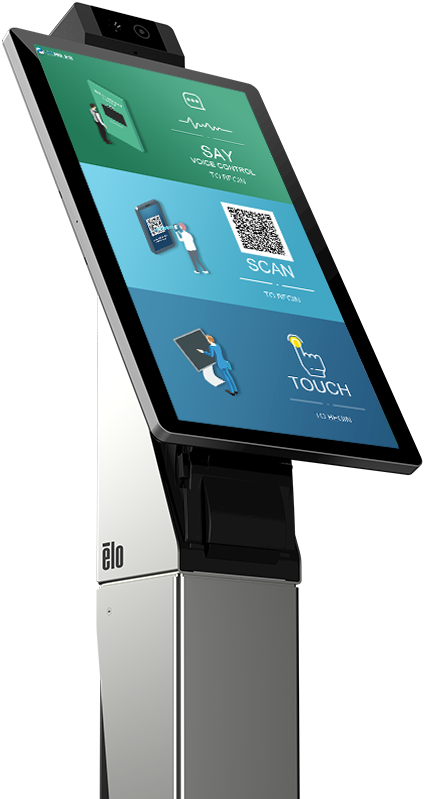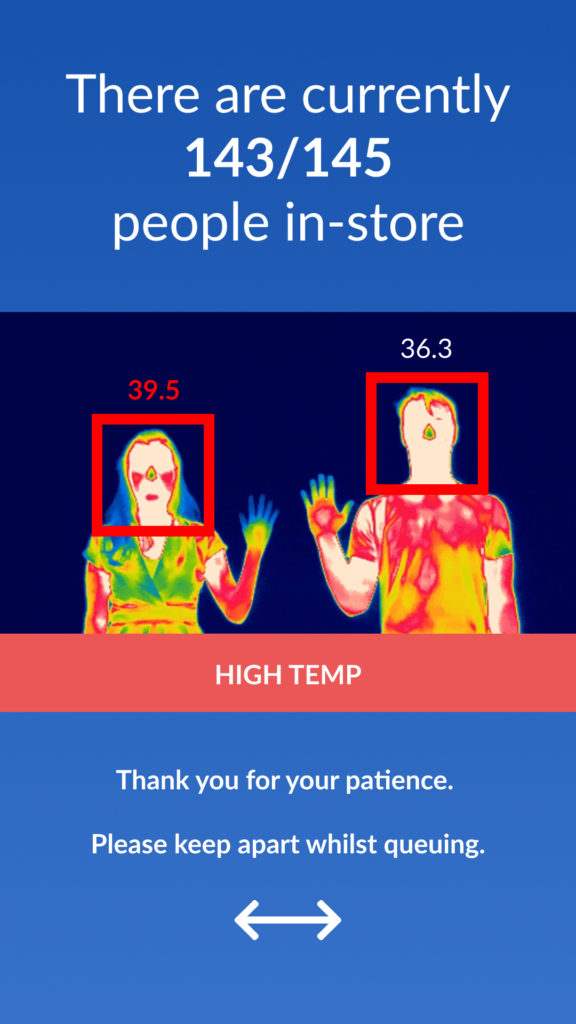
Screen-based COVID Counter-Measures Keep On Coming
October 22, 2020 by Dave Haynes
Back in late Q1 and early Q2, when the gravity of the pandemic really grew evident, there was an initial flood of companies rapidly developing and marketing a series of screen-based counter-measures aimed at retailers, restaurant operators and businesses.
I wondered how much take-up there might be of all of these devices, and if the flood would slow to a trickle as the world got on top of the virus.
Well, the products keep coming and the world, with some notable exceptions, has not got on top of the spread. We seem to be going backwards, in general.
Every morning, there are numerous emails from Shenzhen in mangled English – with greetings that range from Mr. Dave to Darling – pitching sensors and dispensers. And I am still seeing more and more companies that I actually know, from North America, Europe and elsewhere, releasing new products or refinements on existing ones.
Here’s a sampling just from the last day or so:
Middletown, CT-based Reality Interactive, a longtime interactive solutions provider, has launched the AXSIS™ Thermal Scanner Enabled Digital Hub – described as providing a 100% contactless body temperature check in just seconds, which helps keep your workforce safe, and also gives management a comprehensive view of the day-to-day health status of their employee population. Integration into our powerful bitSHUTTLE Content Management Platform brings new innovations such as a fully-customizable door lock feature which allows control of an existing door lock system, and includes helpful usage data and analytics.
The interesting note on this one, for me, is how the company says it seeing marketplace adoption.
We are currently operating the AXSIS Thermal Enabled Digital Hub with a major U.S. Retailer in thousands of their stores nationwide, handling the traffic of thousands of employees.
My shopping outings are pretty much Costco, Home Depot, groceries and the local Nova Scotia Liquor Corporation shop, so I may not be the final word on this, but I have yet to see a sensor or dispenser out there. It makes some sense that they are getting used “back of house” – as I am sure lots and lots of people already freaking out about their freedom threatened by mask requirements would go thermonuclear if they were asked to do a face scan.
Silicon Valley-area CMS firm 22 Miles has had its TempDefend thermo-sensing software and hardware solution on the market for a while now, but has added an integration with the touch display company Elo.

The combined solution including Elo I-Series touchscreen computers, Mounting Solutions, Temperature Sensor Pro, EloView and 22Miles software brings plug-and-play, self-service thermal detection capabilities to a wide range of industries and applications, from enterprise and hospitality, to education and transportation, and many more.
As more industries re-open and plan for 2021 and beyond, businesses face a growing number of safety and logistical issues. Leveraging digital signage allows business leaders to communicate and support solutions for safety and productivity post-COVID, including social-distancing regulations, employee screening, building floor plan restructuring and design, and changes to technology use that come with keeping employees and building visitors safe and well-informed.
Engineered as a customizable, plug-and-play thermo-sensing digital signage communication and direction tool, 22Miles’ TempDefend combines advanced camera hardware, facial and body temperature detection software, integrated sensors, and dynamic machine learning algorithms. With Elo’s I-Series, 22Miles will provide an all-in-one display and software solution that can be quickly and easily installed in buildings of any size and scale. Elo’s accessory and mounting portfolio creates an easy-to-configure solution for any environment. EloView SaaS service (available for Elo Android devices) helps enable seamless remote deployment of TempDefend and device management capabilities.

UK-based Acquire Digital, located in Leicester, has launched several COVID-19 solutions built around the idea of contactless.
Acquire Mobile Control is a contactless software that allows a user to use their mobile device to scan a QR to use a web-based trackpad to control the display. The Mobile Control functionality does not require users to download an application and provides real-time interaction without touching the screen.
Acquire Voice Control works similarly to ‘Amazon Alexa’ where users speak commands to a traditional kiosk to control its functionality and view content. Tailored for Acquire’s Wayfinder Directory application, the add-on solution is configured to leverage speech to navigate the application.
Acquire Wave enables service providers to detect a user’s hand in mid-air, converting it to an on-screen cursor, and supporting interaction methods that users are familiar with. Simple hand gestures offer full control of the application without touching the screen.
The company, operating in the Leicester area (home of my fave Premier League team, Leicester City), has also debuted a SmartEntry system that uses Acquire’s digital signage software and an Intel RealSense Camera installed at the entrance to do a traffic light-like access control system for retail and other businesses that get public traffic.
The feature leverages facial recognition and crowd control technologies to create a footfall counter and entrance flow management system. The gathered data can be displayed on-site for easy viewing and a wide range of analytics are available within the Acquire dashboard for further analysis. If capacity has been reached within an establishment, a message will appear on the display informing visitors to wait until other visitors exit.
Combine the SmartEntry people counter with temperature screening capabilities by adding a body temperature thermal camera to confirm a visitor is within the ‘safe range’ to enter the facility. The on-screen messaging informs visitors if they are safe to enter to limit exposure to high risk individuals.
The SmartEntry system reduces unnecessary interactions, increases efficiency, and can relieve staff members of queue management tasks.
The challenge, I think, with all of these solutions is ensuring resellers and end-users that the technology investment has a use post-COVID, and also that measures such as these sensors are accurate and therefore valid.
There has been plenty of debate as to whether these devices are sufficiently accurate, or just a theatrical exercise to make people feel a little more comfy or allow users to think and show that they are doing something.



No Privacy Rights? Protection from public shaming?